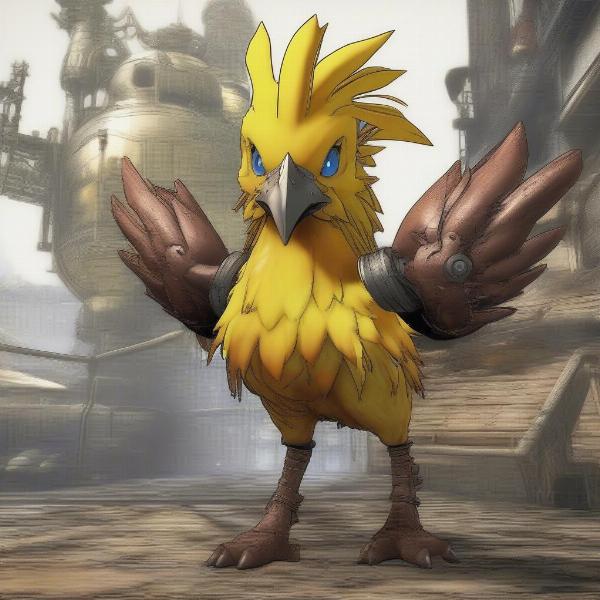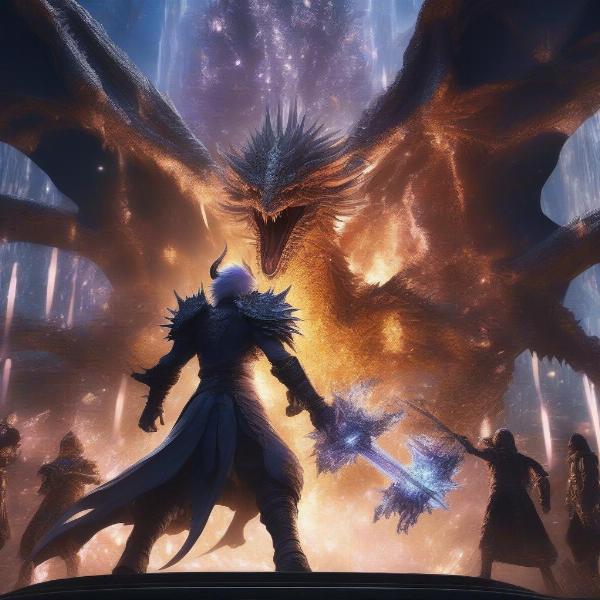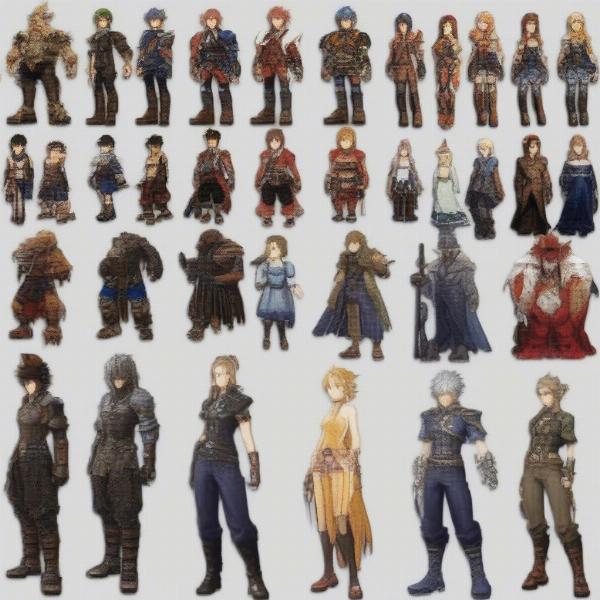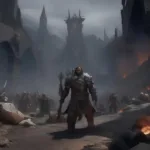The Final Fantasy series, a sprawling epic of crystals, chocobos, and ridiculously oversized swords, has captivated gamers for decades. But with so many entries, spin-offs, and sequels, a common question arises: Are Any Of The Final Fantasy Games Connected? The answer, like many things in the realm of Spira, is complicated. Let’s dive into the intricate web of Final Fantasy lore and connections.
For newcomers, the sheer number of Final Fantasy titles can be daunting. It’s reassuring to know that, for the most part, each numbered entry is a standalone story. You can jump into Final Fantasy VII without having played VI, or explore the world of X without touching IX. Each game boasts its own unique characters, setting, and plot, allowing players to experience a complete narrative within each installment. This design choice makes the series accessible to a wider audience. You don’t need to be a seasoned veteran to enjoy the latest Final Fantasy game.
However, that doesn’t mean the games exist in complete isolation. While direct narrative sequels are rare, there are subtle nods, recurring themes, and shared mythologies that weave a delicate thread between certain titles. For example, the concept of crystals as sources of power, the presence of summoned creatures (often called Espers or Guardians), and the recurring motif of a chosen warrior destined to save the world are just a few of the common threads that tie the series together. These shared elements create a sense of familiarity and shared history, even across drastically different game worlds. Thinking about trying out Final Fantasy VII Remake? You might enjoy reading up on why the trilogy PS1 games ost is so good first. why is the trilogy ps1 games ost so good
Are There Any Direct Sequels?
Yes, although they are less common than standalone titles. Final Fantasy X has a direct sequel, Final Fantasy X-2, continuing the story of Yuna and her companions. Similarly, Final Fantasy XIII has two direct sequels, XIII-2 and Lightning Returns: Final Fantasy XIII, forming a complete trilogy. These sequels build upon the established lore, characters, and gameplay mechanics of their predecessors, offering a deeper dive into their respective worlds.
How About Shared Universes?
The concept of shared universes is where the connections become more nuanced. The Ivalice Alliance, encompassing Final Fantasy XII, Final Fantasy Tactics, and Vagrant Story, shares a common world and history, although the stories themselves are largely independent. Similarly, Final Fantasy VII has expanded into a compilation of games, including Crisis Core, Dirge of Cerberus, and Advent Children, which flesh out the world and lore surrounding the original game.
Are There Recurring Characters or Elements?
Beyond direct sequels and shared universes, there are recurring elements that pop up throughout the series. Cid, a character often associated with airships or technology, appears in various forms across numerous Final Fantasy games. Similarly, the Chocobo, a large, flightless bird, has become a series staple, often used as a mode of transportation. These recurring elements add a layer of continuity and fan service to the series, rewarding long-time players with familiar faces and concepts.
 Final Fantasy Recurring Elements: Chocobos and Cid
Final Fantasy Recurring Elements: Chocobos and Cid
What About Spiritual Connections?
Some games, while not directly connected, share thematic or stylistic similarities that create a sense of spiritual kinship. Final Fantasy IV and VI, for example, both explore themes of political intrigue and moral ambiguity, despite having distinct stories and settings. These thematic echoes resonate with players, creating a sense of connection that transcends narrative continuity. Interested in watching the Eagles game? Check out how to watch Eagles games out of market. how to watch eagles games out of market
Do Spin-offs Affect the Main Storyline?
Generally, spin-offs do not impact the main numbered entries. Games like Final Fantasy Tactics or the Crystal Chronicles series offer unique gameplay experiences and explore different aspects of the Final Fantasy universe, but they don’t significantly alter the core narratives of the main games.
So, Are They All Connected?
The short answer is: not directly, in most cases. Each numbered Final Fantasy game is typically designed as a standalone experience. However, recurring themes, shared mythologies, direct sequels in certain cases, and expanded universes through spin-offs and compilations create a web of interconnectedness that adds depth and richness to the series as a whole. Think of it as a constellation of stories, each shining brightly on its own, yet subtly connected by invisible threads of shared history and recurring motifs.
Additional Insights into the Final Fantasy Universe
The Impact of Crystals on Final Fantasy Lore
Crystals are a recurring element throughout the Final Fantasy series, often serving as sources of power, magic, or even life itself. Their presence can influence the plot, characters, and world-building of many games, offering a consistent thematic thread across different storylines.
The Role of Summons in Final Fantasy Games
Summons, powerful magical creatures that aid players in battle, are another recurring element. From the iconic Ifrit and Shiva to more obscure entities, these summons add a layer of strategic depth and visual spectacle to the combat system. Wonder what’s happening in the LSU game? Check out the latest score update. what's the score in the lsu game
 Final Fantasy Summons and Crystals: Power and Magic
Final Fantasy Summons and Crystals: Power and Magic
Exploring the Music of Final Fantasy
The music of Final Fantasy, composed by Nobuo Uematsu and others, is renowned for its emotional depth and melodic complexity. From sweeping orchestral pieces to catchy battle themes, the music plays a crucial role in enhancing the narrative and emotional impact of each game.
The Evolution of Final Fantasy Gameplay
Over the years, Final Fantasy gameplay has evolved significantly, from the turn-based combat of the early titles to the more action-oriented systems of recent entries. This constant evolution has kept the series fresh and engaging, attracting new players while retaining the core elements that define the franchise.
 Final Fantasy Character Evolution: Classic and Modern
Final Fantasy Character Evolution: Classic and Modern
Conclusion
While each Final Fantasy game can be enjoyed as a standalone experience, exploring the connections, recurring elements, and shared mythologies enhances the overall appreciation of the series. The interconnectedness, subtle as it may be, adds a layer of depth and richness to the Final Fantasy universe, making it a truly rewarding experience for long-time fans and newcomers alike. So, dive in, explore, and discover the magic that connects these fantastic worlds. What are your favorite connections between Final Fantasy games? Share your thoughts in the comments below!
FAQ
-
Do I need to play all the Final Fantasy games in order? No, most games can be played standalone.
-
Which Final Fantasy games have direct sequels? Final Fantasy X and XIII have direct sequels.
-
What is the Ivalice Alliance? A shared world encompassing Final Fantasy XII, Final Fantasy Tactics, and Vagrant Story.
-
Who is Cid? A recurring character often associated with airships or technology.
-
What are Chocobos? Large, flightless birds commonly used for transportation in the Final Fantasy series.
-
Are the spin-off games important to the main story? Generally, no.
-
Are there any recurring themes in Final Fantasy games? Yes, such as crystals, summons, and chosen warriors.

